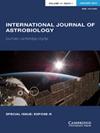Self-replicating probes are imminent – implications for SETI
IF 1
4区 物理与天体物理
Q3 ASTRONOMY & ASTROPHYSICS
引用次数: 3
Abstract
Abstract In the early 1980s, the Sagan-Tipler debate raged regarding the interpretation of the Fermi paradox but no clear winner emerged. Sagan favoured the existence of ETI on the basis of the Copernican principle and Tipler favoured the non-existence of ETI on the basis of the Occam's razor principle. Tipler's stance was an expansion of the similar but earlier Hart declaration. However, crucial to the Tipler argument was the role played by self-replicating interstellar robot probes. Any technologically capable species will develop self-replication technology as the most economical means of exploring space and the Galaxy as a whole with minimal investment. There is no evidence of such probes in our solar system including the asteroid belt, ergo, ETI do not exist. This is a powerful and cogent argument. Counter-arguments have been weak including Sagan's sociological explanations. We present a Copernican argument that ETI do not exist – humans are developing self-replication technology today. We are developing the ability to 3D print entire robotic machines from extraterrestrial resources including electric motors and electronics as part of a general in-situ resource utilization (ISRU) capability. We have 3D-printed electric motors which can be potentially leveraged from extraterrestrial material that should be available in every star system. From a similar range of materials, we have identified a means to 3D print neural network circuitry. From our industrial ecology, self-replicating machines and indeed universal constructors are feasible. We describe in some detail how a self-replicating interstellar spacecraft may be constricted from asteroidal resources. We describe technological signatures of the processing of asteroidal material (which is expected to be common to most star systems), and the excess production of certain types of clay and other detritus materials. Self-replication technology is under development and imminent – if humans are pursuing self-replication technology, then by the Copernican principle, so would any technologically savvy species elsewhere. There is no evidence that they have.自我复制的探测器对SETI的影响迫在眉睫
摘要在20世纪80年代初,关于费米悖论的解释,萨甘·提普勒争论愈演愈烈,但没有明确的赢家出现。萨根在哥白尼原理的基础上赞成ETI的存在,蒂普勒在奥卡姆剃刀原理的基础下赞成ETI不存在。蒂普勒的立场是类似但更早的哈特宣言的扩展。然而,对提普勒争论至关重要的是自我复制的星际机器人探测器所扮演的角色。任何有技术能力的物种都将开发自我复制技术,将其作为探索太空和整个银河系的最经济手段,只需最少的投资。没有证据表明在我们的太阳系中有这样的探测器,包括小行星带,呃,ETI不存在。这是一个有力而有说服力的论点。包括萨根的社会学解释在内的反驳一直很弱。我们提出了一个哥白尼式的论点,认为ETI并不存在——今天人类正在发展自我复制技术。作为通用原位资源利用(ISRU)能力的一部分,我们正在开发从地外资源(包括电动机和电子设备)3D打印整个机器人机器的能力。我们有3D打印的电动马达,可以利用每个恒星系统中都应该有的地外物质。从类似的材料中,我们已经确定了一种3D打印神经网络电路的方法。从我们的工业生态来看,自我复制的机器和通用的建设者是可行的。我们详细描述了一个自我复制的星际飞船是如何被小行星资源限制的。我们描述了处理小行星物质(预计这在大多数恒星系统中都很常见)的技术特征,以及某些类型的粘土和其他碎屑物质的过量生产。自我复制技术正在开发中,而且迫在眉睫——如果人类正在追求自我复制技术,那么根据哥白尼原理,其他任何精通技术的物种也会如此。没有证据表明他们有。
本文章由计算机程序翻译,如有差异,请以英文原文为准。
求助全文
约1分钟内获得全文
求助全文
来源期刊

International Journal of Astrobiology
地学天文-地球科学综合
CiteScore
3.70
自引率
11.80%
发文量
45
审稿时长
>12 weeks
期刊介绍:
International Journal of Astrobiology is the peer-reviewed forum for practitioners in this exciting interdisciplinary field. Coverage includes cosmic prebiotic chemistry, planetary evolution, the search for planetary systems and habitable zones, extremophile biology and experimental simulation of extraterrestrial environments, Mars as an abode of life, life detection in our solar system and beyond, the search for extraterrestrial intelligence, the history of the science of astrobiology, as well as societal and educational aspects of astrobiology. Occasionally an issue of the journal is devoted to the keynote plenary research papers from an international meeting. A notable feature of the journal is the global distribution of its authors.
 求助内容:
求助内容: 应助结果提醒方式:
应助结果提醒方式:


